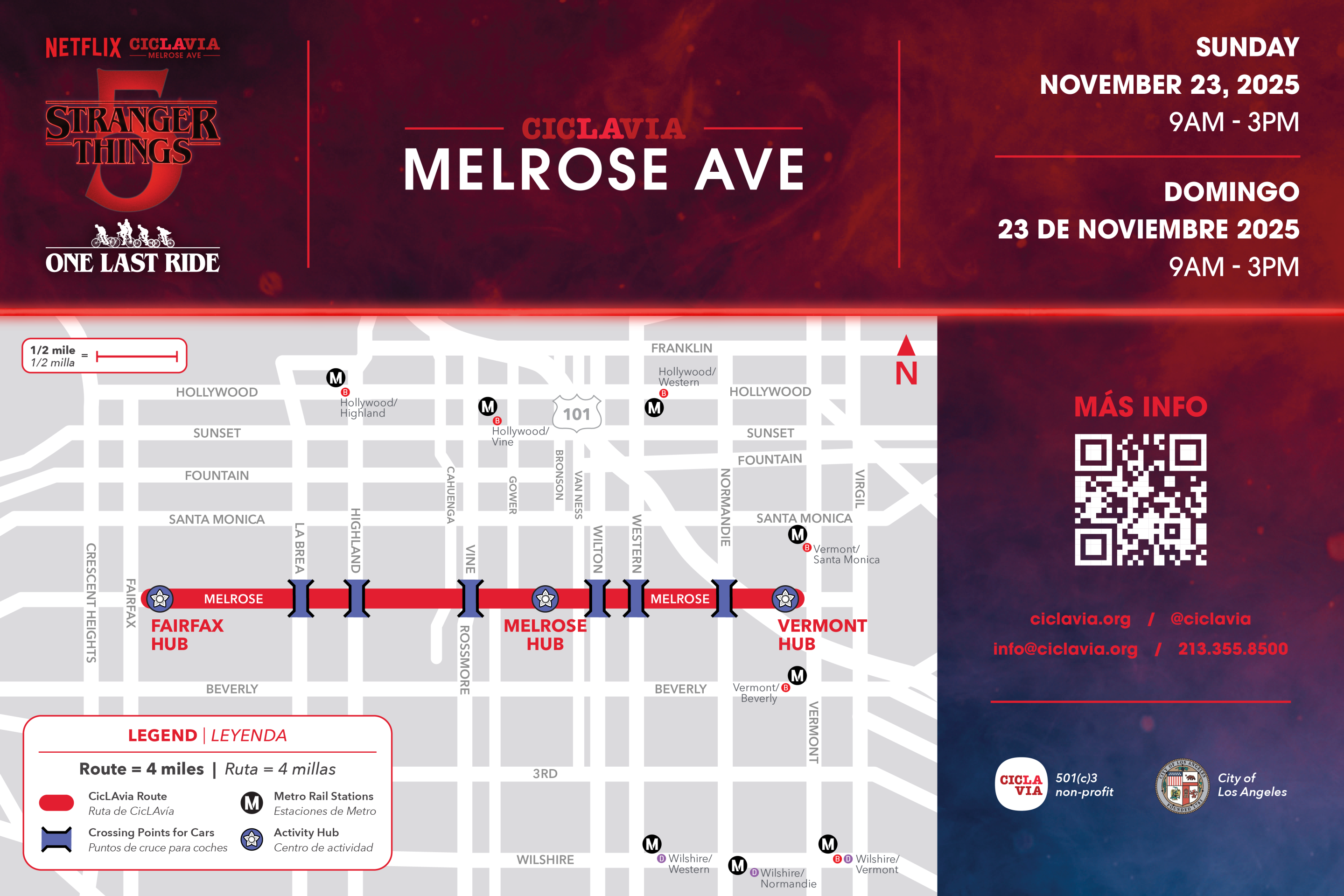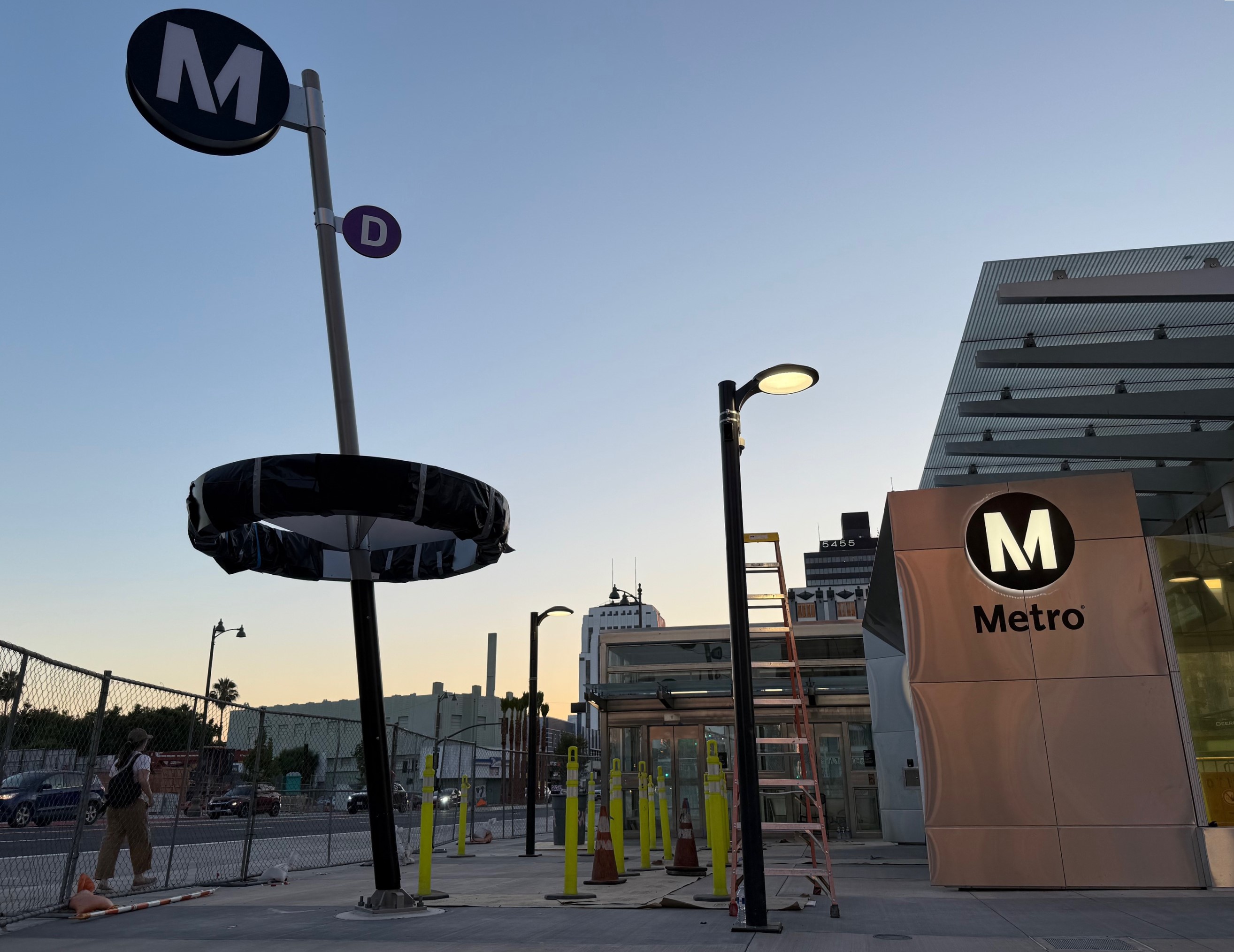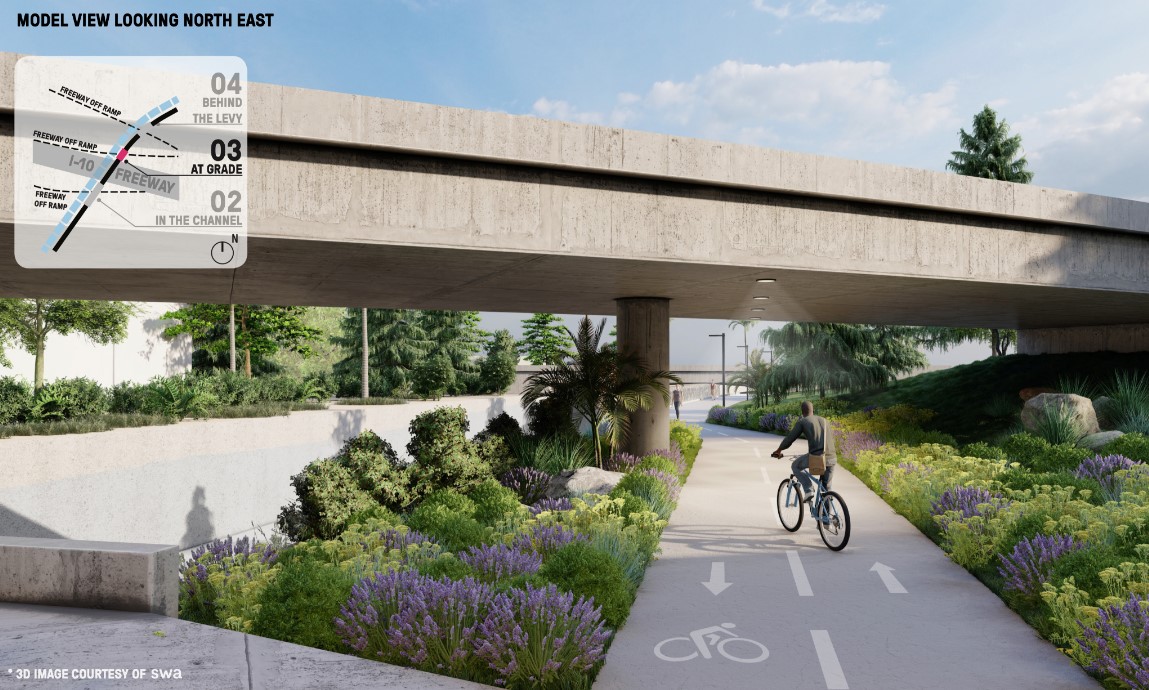 Aurisha Smolarski talks to Fox 11 after the first Car-Free Friday.
Aurisha Smolarski talks to Fox 11 after the first Car-Free Friday.Eleven years ago, a small group of bike riders that included Streetsblog contributors Joe Linton and Ron Milam, founded the Los Angeles County Bicycle Coalition, the county's largest bicycle advocacy organization. The LACBC always has a bunch of plates spinning in the air, so I caught up with LACBC staff Aurisha Smolarski and Dorothy Le to find out everything that's going on with the LACBC. For more information about the LACBC, visit their website at http://la-bike.org.
Streetsblog: Let's start with the obvious question. Where are we on the city's Bike Plan? What's the LACBC's strategy?
Dorothy: We haven't seen the full Bike Plan yet, just some of the maps. We're expecting the policy document soon, maybe in the next couple of weeks. And then once that's out there, there will be public meetings.
Aurisha: We're putting out the maps to as many people as we can to encourage people to submit comments.
We're also writing a letter asking that the "infeasible" category be changed to something else. To us infeasible means "no" and that's not cool. We have put out other ideas such as "possibility streets" or "potential streets." We want to work with them to change that language.
We're also putting together a list of streets that are currently in the "infeasible" category, that we feel should actually be "proposed bike lanes". These would have a lower amount of street reconfiguration needed to install lanes.
Dorothy: Third, there are the streets that we want to add that aren't even on the current Bike Maps.
Aurisha: One of our main concerns is the current maps look like a step back from the 1996 plan. Many of the proposed bike lanes from the 1996 plan are now in the 'infeasible' category. So the current plan draft is actually proposing fewer bike lane mileage than it had in 1996.
That's a step backwards in our eyes.
Streetsblog: Do you have any insight on what that policy document is going to look like or what it says?
Dorothy: We haven't heard a lot on it…
Aurisha: …but we have heard that it's a lot better than the maps, but not much else about the document. I'm hoping that it's pretty good. Some of the people that I know who have been involved with the plan have said that they wish the policy document had been released with the maps and there would have been fewer backlashes from the bicycling community.
That says to me it could be better than the maps.
Streetsblog: So let's talk about Sharrows. What the heck is taking so long? It keeps looking like we're ready to roll and then….delay…
Aurisha: No matter what excuses, the issue always seems to be about funding and timing with the LADOT. LADOT says the delay is because they don't have enough time, they don't have enough staff, they don't have the money, they can't work on this and the Bike Plan at the same time. Now, we're trying to get funds from private donors and we're waiting to hear back on that.
We've had a lot of support from Eric Garcetti's office, but we would like to see Garcetti and the Mayor use their leadership to push LADOT to prioritize this project. Implementation in 2009 is our goal.
Streetsblog: 2009 is over half over.
Aurisha: It is! But if they paint the Sharrows on Christmas Eve I'd be happy.
I've had a conversation with Rita Robinson where she's also expressed surprise that it's taking this long. She says she's going to talk to bikeways staff, but the reality is it's all about priorities.
Streetsblog: So what do you think about the Sharrows and painted lanes in Long Beach?
Aurisha: Awesome, awesome, awesome. They're gorgeous. It makes me jealous.
Streetsblog: Four months from sketches to on-the-ground.
Aurisha: Department of Transportation is quick to say that L.A. is not Long Beach and our streets are different than anywhere else. (editor's note: yeah, they're wider. They had to fit streetcars) We've been pushing them to implement these Sharrows because that's what's important to us.
 Dorothy and Aurisha at "Car-Free Wilshire" on Earth Day
Dorothy and Aurisha at "Car-Free Wilshire" on Earth DayStreetsblog: So let's move on. You've been doing some work on the "4th Street Bike Boulevard?"
Dorothy: A lot of people have worked on this before and are still working on it: to try and make 4th Street a better place to bike. To make it a true Bike Boulevard. First, let's acknowledge all the work that's already been done.
Now we're just building off that effort, and putting some of our political muscle behind them. Right now, we're trying to get a second section of the street repaved. A couple of months back the city repaved a stretch of 4th Street between Hoover and Norton, and now we're trying to get them to do the same thing between Norton and La Brea.
But this is a lot more than repaving. The big question is how we create the political will and funding to get the kind of treatments that would make 4th a true Bike Boulevard. Right now we're meeting with people to find out exactly what they want exactly where they want it. People talk to us about chokers, traffic circles, Sharrows…
Streetsblog: Everybody loves the Sharrows
Dorothy: Why not?
Aurisha: People have been talking about 4th Street for a long time, and it's listed in the Bike Plan as a Bike Friendly Street, so we think we can do this. Also, 4th Street is one of the streets that will get Sharrows as part of the pilot.
Also, let me add that it's crucial for the Mayor to get involved with these issues. Whether it's the Bike Plan, or Sharrows or Bike Boulevards, all of these things can positively impact the environment which is why we're asking him to make these bike projects a priority. He says he's committed to sustainability, and (getting behind) these types of proposals would be a great way to show it.
Streetsblog: It's a kind of paradox with him, because he's pretty good on transit issues but so bad on bicycle and pedestrian issues. I mean with Measure R…
 Le with Metro's James Rojas at a Site LA event on the future of transportation planning.
Le with Metro's James Rojas at a Site LA event on the future of transportation planning.Dorothy: Well, with Measure R we still have to get our share.
Streetsblog: We did a little coverage of City of Lights when you launched it, but why don't you take this chance to tell us a little more about it?
Dorothy: City of Lights is a program that works to increase bike safety and advocacy among low-income communities in Los Angeles. Right now we're handing out lights and doing some safety education in underserved areas such as the Highland Park area…We're hoping that in the fall we can start talking about advocacy, what the cyclists want as a community; what kind of infrastructure changes would make their rides easier and safer. It will be much more campaign focused in the fall and in the future.
Streetsblog: So there's a lot more to this than giving out lights
Aurisha: One of the main goals of this program is to activate these communities to advocate for what is important to them as cyclists. We're hoping that our interaction with them will lead to participation in some important campaigns, thus contributing to create a stronger voice for all of us. Issues like the bikes on trains being discussed by Metro will effect them, and they need to be heard. I think it would make a big difference if policy makers heard them. There are many more people interested in bike issues than those who are out there speaking, a lot of people have to work and aren't making it to afternoon hearings.
Streetsblog: Changing gears, let's talk about the relationship with the police. There have been a couple high profile incidents recently, the Hummer incident and a cyclist being killed in a crosswalk and blamed for her own death by the police being two of them, that are starting to catch the public eye a little bit. What do you see as the state of the relationship between cyclists and the LAPD, and what should we be doing about it?
Aurisha: Recently, I've been on the phone everyday trying to get a meeting. The LAPD is getting to know me, it's like "Hey, Aurisha!" everytime I call now.
The City Council Transportation Committee has told them that they need to reach out to cycling advocates to put together a comprehensive workshop (for officers) on bike rules and rights. After two weeks of unreturned phone calls I was finally able to schedule a meeting with Commander Michael Williams. I'm not going to stop until we have these workshops scheduled and we make sure that they are getting the information out to their officers.
In general, there is a lot of missing information and a lack of education when it comes to cyclists rights to the road. We need to make sure they have all the correct information so they can enforce the laws more justly.
Dorothy: As for what cyclists can be doing when they're getting bad tickets, we're working on a resource page about how to fight bad tickets, what are the rules of the road, what are the specific laws under the Municipal Code and state law and what are your legal options.
Ideally, cyclists could carry the law with them. So when you're pulled over by a police officer you can have the Municipal Code, with the identifying numbers, on hand. There are also avenues for filing formal complaints to the LAPD on top of contesting the ticket, but it's not something a lot of people are doing. Also, we need to go to the Police Commission more. That group meets at LAPD headquarters and has direct oversite over the LAPD and needs to know what's happening on the streets.
We're hoping that as more people file complaints and we get these workshops going that we can turn this around.
Aurisha: One of the things we're seeing now is a lot of the tickets are being left up to "officer discretion" about what some of these rules mean and whether or not to give a ticket. So if you have an officer with an anti-bike bias, you're going to see bad tickets. This has to change, because people get different tickets in different places depending on who you are and where you are. That's becoming more and more apparent.
Streetsblog: So there's a lot going on and you've got a lot of balls in the air. But you're real strength comes from your members. Is membership growing? I know a lot of non-profits are seeing a dip because of the economy.
Aurisha: We've seen our membership go up in the past year for two reasons. First, the cycling community is growing and second we've stepped up our outreach and our advocacy efforts. More people want to get involved in the issues that affect them. We're seeing more people at more events getting more involved. Fortunately, one of those things is signing up as a member of LACBC. (editor's note: interested in membership? Visit their new members website here http://www.la-bike.org/
Streetsblog: So my typical last question is, if you could wave a magic wand and change something about L.A.'s transportation network what would it be?
Dorothy: Less space for cars. More space for non-motorized traffic. More space for transit users. That could mean taking away parking. Taking away some car travel lanes. I'm not saying take away parking and not giving people a chance to park anywhere, but we need to think bigger than that. There's ways to limit parking that makes the roads more usable for everyone.
Aurisha: I'd like to see a system that's geared towards moving people and not just moving automobiles. In separating interests, you have to examine what other cities have done to address mobility and bike issues to create more sustainable cities. I would like to see an LA that has more bike lanes, more respect for cyclists and a prioritization for non-motorized travelers in general.






